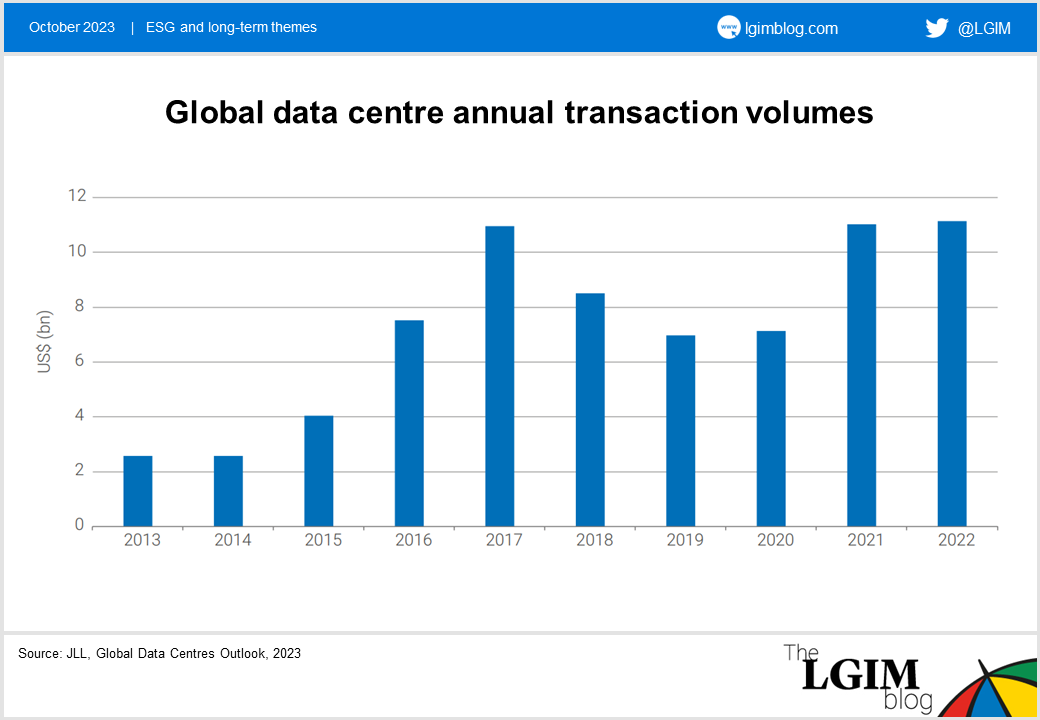Disclaimer: Views in this blog do not promote, and are not directly connected to any L&G product or service. Views are from a range of L&G investment professionals, may be specific to an author’s particular investment region or desk, and do not necessarily reflect the views of L&G. For investment professionals only.
Real assets: AI in the real world
The data volumes and computing power required for AI are likely to boost the prospects for data centres and renewable electricity generation.

The following is an extract from our latest CIO Outlook.
Infrastructure and real estate can generate long-term, sometimes counter-cyclical income streams when there are structural imbalances in supply and demand. We believe the widespread adoption of AI will trigger such a shift in demand.
This is likely to create equity and debt investment opportunities, alongside potential operational efficiencies in the management of existing assets. While some of the longer-term consequences of AI adoption are uncertain, from a Real Assets perspective there are three outcomes in which we have high conviction:
- A rapid increase in requirements for data processing and storage facilities
- Substantial additions and upgrades to digital infrastructure networks
- Increased electricity generation, storage and distribution requirements
Data centres and renewable energy
We expect a material positive impact on the investment prospects for data centres[1] and renewable electricity generation. The computing power and data volumes required for AI is significantly greater than for other digital tasks.
AI applications typically use around 30kW of power per rack[2], according to Knight Frank, whereas more traditional data centre racks need 8-10 kW. This thirst for greater computing power nets out to greater physical space requirements: Green Street reported record-breaking demand for data centre space in the second quarter of this year.
We anticipate that it will be challenging for supply to keep pace with this growing demand. Power constraints are already restricting data centre development in Frankfurt, while increased planning hurdles are likely to emerge as local authorities seek to understand these large sites with comparatively low employment density. Increased space demands combined with restrictions around new supply are likely to create favourable supply and demand dynamics, supporting rental growth.
Data centres do have negative environmental externalities, with their networks estimated to account for 1.5% of global electricity use in 2022,[3] despite the sector remaining in its infancy. The International Energy Agency highlights the materiality of the potential future electricity requirements of the sector, noting that data centres accounted for 18% of Ireland’s electricity consumption in 2022, with the potential to increase to 28% by 2031.

To support the rollout of AI without undermining the transition to net-zero carbon emissions, data centres will likely require further efficiency improvements alongside increased renewable energy generation. Modern data centres have already made substantial improvements in energy efficiency, and we expect the sector to continue to innovate to contain the growth in energy demands.
The growth in data usage and storage, turbocharged by generative AI, represents a tailwind in support of further investment to upgrade digital and renewable energy infrastructure networks. The potentially huge sums involved could, in turn, lead to lending opportunities within private credit.
High-quality, human environments
Perhaps counter-intuitively, more automation of analytical and clerical processes through AI may, in our view, increase the value associated with creativity, idea generation and human interaction. While there might be some negative implications for overall office demand, we think AI could increase the focus on high-quality spaces, be it best-in-class offices or leisure and hospitality environments.
We note that leisure has grown as a proportion of consumer spending over the past decade, despite a concurrent rapid growth in digital connectivity and usage, reflecting the continued value of social spaces within a more digital world.
All this said, we should not underestimate the risks associated with AI – notably around data security, the potential displacement of workforces and the environmental costs of increased power requirements not being met by equivalent increases in clear energy generation. However, we see AI as a material trend with upside potential for productivity and growth, creating new investment opportunities within the real assets universe.
The above is an extract from our latest CIO Outlook.
[1] Data centres are facilities designed to house and operate critical computing infrastructure that organisations use to assemble, process and store large amounts of data. AI use requires different cooling technology to ‘normal’ data storage and there are therefore building specification implications.
[2] A data centre rack is a physical steel and electronic framework that houses data servers, networking devices, cables and other computing equipment
[3] IEA, July 2023
Recommended content for you
Learn more about our business
We are one of the world's largest asset managers, with capabilities across asset classes to meet our clients' objectives and a longstanding commitment to responsible investing.

